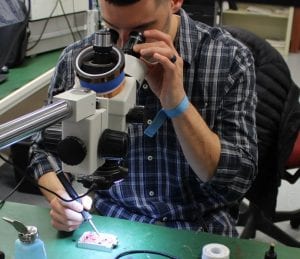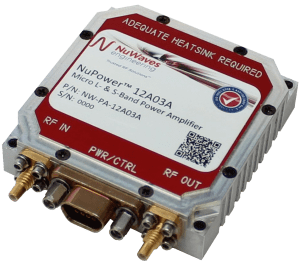Building on our previous blog on pulse recovery testing, we present the measurements of pulse recovery time for a commercially available GaN MMIC amplifier with a 5 to 9 GHz bandwidth. The amplifier was assembled into a metal housing, with 2.4 mm connectors used to interface with the test equipment. Three separate units were tested, with the results being consistent among all units. Therefore, we present the results for one unit in the interest of brevity.
We begin by presenting an example of a pulse recovery time measurement in the image above. The interferer pulse is shown in magenta, whereas the desired signal is shown in red. We can see that desired signal is heavily distorted when the interferer is activated, and then recovers once the interferer is disengaged. The recovery is measured as the rise time from 10% to 90% of the signal level.
Next, we observe the pulse recovery times versus input energy under short pulse conditions appears to increase monotonically with increasing input energy, though the relationship appeared to be nonlinear.
We next observed the pulse recovery times versus input energy under long pulse conditions. We note the recovery time increases monotonically with increasing energy, and follows the same trend as the short pulses.
In considering the results for short pulses versus long pulses, we did notice that the recovery time was not solely dependent on the incident energy. Indeed, there were two sets of short pulse and long pulse measurements with the same incident energy, but much different recovery times. Additionally, recovery time vs. energy data is available in our tech brief.
We note that the longer pulses with lower power had a much longer recovery time than the shorter pulses with higher power, even though they had near identical incident energy. Therefore, it appears that pulse recovery time, while being dependent on incident energy, is also dependent on the incident action (energy times duration, uJ-us) of the interfering signal. This is an interesting phenomenon we will explore in future work.
Conclusion
In this two-part blog series, we presented a methodology for measuring the pulse recovery times of GaN low noise amplifiers in the presence of high power, out-of-band jamming signals. Pulse recovery time is becoming an important metric for assessing system performance. In our examination of a commercially available 5 to 9 GHz GaN LNA, we considered jamming signals that operated under short pulse (< 10 us) and long pulse (> 100 us) conditions. We found that in each case, the recovery time was mathematically related to the input energy through a radical relationship. However, the pulse recovery time also appears to be a function of the input action (uJ-us), as short and long pulses with the same incident energy had recovery times that were different by an order of magnitude. In the future, we will explore this phenomenon through more measurements of GaN low noise amplifiers. Article by – Custom MMIC
To review additional test data, and to view the complete findings together, download our tech brief: Understanding the Phenomenon of High-Power Pulse Recovery in GaN LNAs.




